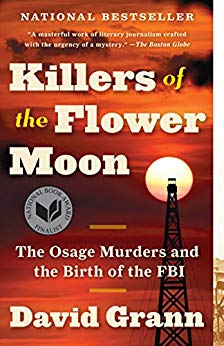

This article is an excerpt from the Shortform summary of "Killers of the Flower Moon" by David Grann. Shortform has the world's best summaries of books you should be reading.
Like this article? Sign up for a free trial here .
What were the Osage murders, and when did they take place? How big was the conspiracy?
The Osage murders took place in Osage County, Oklahoma, in the 1920s. Members of the Osage tribe were murdered as part of a plot to steal the money they made from oil on their land. Local law enforcement failed in their investigation, and the FBI intervened to bring the killers to justice.
Continue reading to find out about the Osage murders in this tragic “reign of terror.”
The Osage Murders: A Violent Conspiracy for Oil Money
Killers of the Flower Moon: The Osage Murders and the Birth of the FBI is about the Osage Reign of Terror—a series of organized killings of members of the Osage Indian tribe that took place in Osage County, Oklahoma during the 1920s. Throughout a five-year period of mayhem and slaughter running from approximately 1921-1926, prominent white members of the community conspired to murder their Osage neighbors—men, women, and children.
The motive for the Osage murders was profit—specifically the oil wealth of the Osage, which they had come into when oil was discovered on their reservation in the late 19th century. Whites in Oklahoma had long schemed to expropriate and defraud the Osage out of their money, largely through a legally mandated system under which individual Osage would be declared financially “incompetent” and court-appointed white guardians installed to oversee their assets. These guardianships offered unbounded opportunities for graft and embezzlement—in many ways, the murderous campaign of the 1920s was merely the logical extension of this long history of exploitation.
After arriving in Oklahoma, White and his handpicked team of agents had to pierce through a web of lies and deceit. Informants who appeared to be working to assist the investigation were revealed to be double agents who were feeding the Bureau misinformation and helping the conspirators get away with their crimes. The unreliability of sources, the reluctance of witnesses to come forward, and blatant corruption of local law enforcement officials made pursuing leads a bewildering exercise, especially once it became clear that the perpetrators were deliberately manufacturing evidence.
But White and his team were undaunted. Through a combination of undercover sleuthing, combing through financial records, and extracting confessions from key witnesses, the agents identified the businessman, power broker, and self-styled “True Friend of the Osage” William Hale as the mastermind behind the Reign of Terror. Hale had powerful business and political connections and had supported the establishment of charities, schools, and hospitals for the Osage. Hale was more than just any local grandee, moreover—he was the uncle of Ernest Burkhart, Mollie Burkhart’s husband. He had been at Anna Brown’s funeral and even vowed to the family that he would seek justice for Anna.
The Bureau agents discovered that Ernest Burkhart and his brother, Bryan, had been willing and active accomplices in their uncle’s murderous conspiracy—Ernest Burkhart had been a party to the murder of his wife’s sisters. In piecing together the puzzle, White’s team saw that the motive for all the Osage Indian murders was simple: profit.
The Headright System and Osage Oil
While individual Osage had been barred by the Tribal Council from buying or selling headrights, they could be inherited. An Osage who suffered many deaths in their family could find themselves with title to multiple headrights. As White studied the probate records dealing with the estates of the Osage murders and their victims, the outline of the murderous plot began to make sense.
Many of the headrights of the victims had been willed to Mollie Burkhart. When all of this money came to Mollie, it would be easy for Hale to exercise control of it through his easily manipulated nephew Ernest—though it would be even easier if Mollie were to be killed, too. This was why Mollie’s family was being systematically eliminated. Through oil headrights and life insurance policies, Hale and his conspirators had a direct financial stake in the deaths of many Osage and the Osage oil murders.
The five-year-long Reign of Terror marked by the Osage Indian murders began in May 1921 with the discovery of the body of a murdered Osage woman named Anna Brown. Anna had been married to a white man, as were her sisters, Mollie Burkhart and Rita Smith.
In these parts of rural Oklahoma in the 1920s, elements of the frontier justice system still remained. Police forces were not yet fully professionalized, so ordinary citizens still assumed some of the responsibilities of criminal justice, including investigation of evidence and even the pursuit of suspects.
Anna Brown, Charles Whitehorn, & the Murder Conspiracy
One of the remaining vestiges of this rough-and-tumble approach to criminal justice was the citizens inquest, in which members of the community would visit the scene of a homicide with the county coroner to collect evidence and record any witness testimony. Anna Brown’s inquest and on-the-scene autopsy were gruesome, hasty, unprofessional, unscientific, and amateurish even by the standards of the day, with no proper protocol or procedure followed and a crowd of onlookers (including Anna’s family) witnessing the whole grisly spectacle.
But Anna’s murder was to be just the beginning. About a week after her body was discovered, another Osage victim was found near an oil rig. This time, the corpse belonged to a man named Charles Whitehorn, who had been missing for about two weeks. Whitehorn was a well-known and popular figure in Osage County, married to a half-white, half-Cheyenne woman. Like Anna Brown, he had been shot in the head—and the bullets appeared to be the same kind as the ones that had killed Anna Brown.
The execution-style murders of two Osage, coming so quickly on the heels of one another, became a prominent story in the local news, as speculation began to mount about who could be responsible. The similar method of killing suggested a link between the two Osage Indian murders, as did their proximity in space and time.
In February 1922, nine months after the bodies of Anna Brown and Charles Whitehorn were discovered, a fit and healthy 29-year-old Osage man named William Stepson suddenly dropped dead. Authorities concluded that he had died of strychnine poisoning. Poison was an ideal way to commit murder in a remote locale like Osage County, with incompetent professional law enforcement professionals and a coroner untrained in forensics, without access to a crime lab.
The spate of mysterious poisonings of Osage men and women continued into July 1923. The community was, rightly, terrified. These were clearly not random homicides—the tribe was clearly being targeted by a well-orchestrated and coordinated campaign of murder. In their distress and desperation, the Osage prevailed upon a white oilman named Barney McBride to journey to Washington, D.C., and use his connections there to lobby the federal government to intercede in the case directly. McBridge was a trusted and benevolent figure among the Osage, and they believed he could intercede effectively on their behalf.
But McBride himself fell victim to the murderous conspiracy, even in faraway Washington, D.C. In August 1922, he was found dead in a culvert in Maryland, a short distance from the capital. Now, the Osage murders were national news. The Washington Post headline blared: “CONSPIRACY BELIEVED TO KILL RICH INDIANS.” The Osage oil murders were in the headlines.
The Osage murders were a series of horrific events. While law enforcement failed, the intervention of the FBI led to changes in law enforcement, and the convictions it brought were considered a victory for the Osage amidst the great tragedy of the Osage oil murders.

———End of Preview———
Like what you just read? Read the rest of the world's best summary of David Grann's "Killers of the Flower Moon" at Shortform .
Here's what you'll find in our full Killers of the Flower Moon summary :
- How the Osage tribe had vast oil wealth, but had it seized by their murderous neighbors
- The brutal and unresolved murders of Osage Native Americans
- The complicated history of the FBI in profiting from the Osage murders






